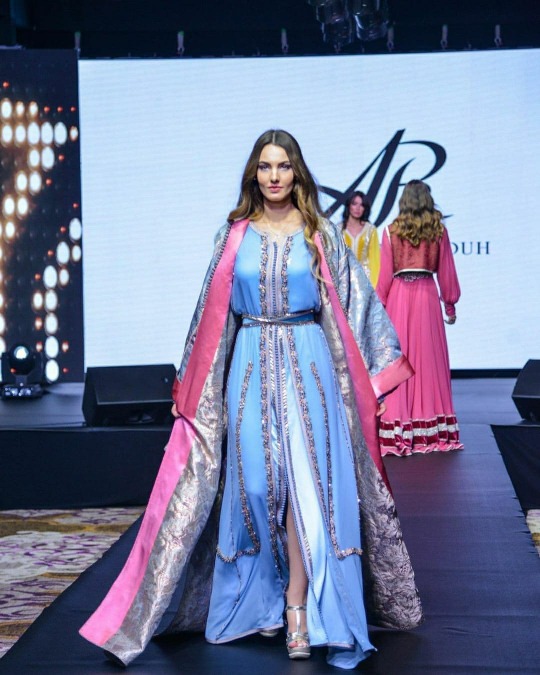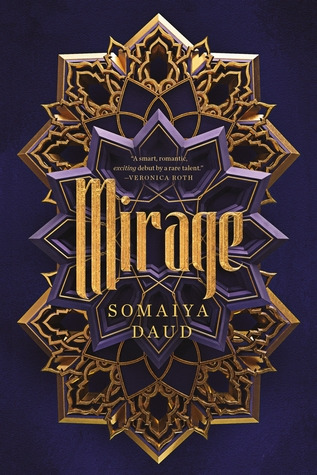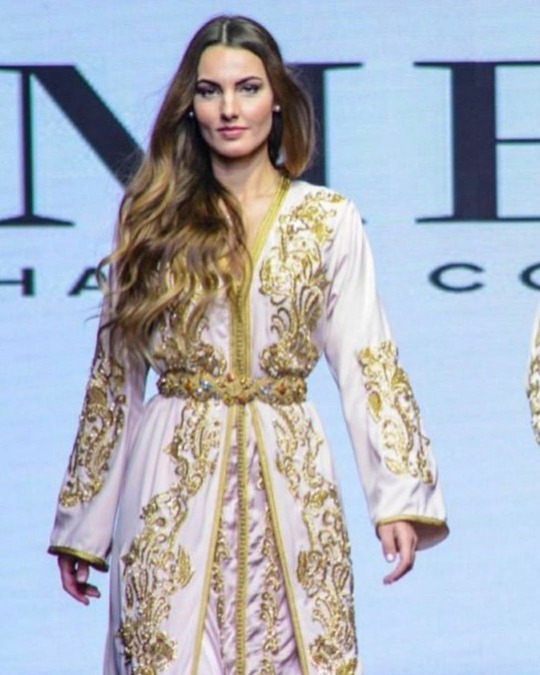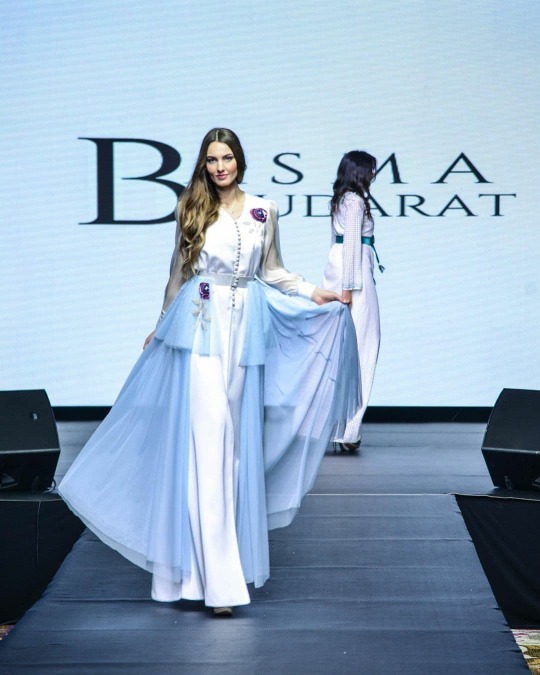#qaftan
Photo

Reposted from @sabela_alvarez 🇲🇦🇲🇦🇲🇦International catwalk 🇲🇦🇲🇦🇲🇦@northluxuryevent @hilton @hiltontangieralhouara . Thanks for having me✨ شكرا يا طنجة . Designer: @abdelhanineraouh_official ✨💖💙 Photo by: @hamouni.mohamed 📸 Hair & makeup: @goldenrosemaroc @wellahair_ma 💄💆🏼♀️ . . #HauteCouture #qaftan #Maroc #طنجة #Tanger #catwalk #internationalmodel #kaftan #desfile #moroccanstyle #moroccancaftan #pasarela #model #stillaDoctor #SabelaAlvarez https://www.instagram.com/p/CXI4wDbMBLl/?utm_medium=tumblr
#hautecouture#qaftan#maroc#طنجة#tanger#catwalk#internationalmodel#kaftan#desfile#moroccanstyle#moroccancaftan#pasarela#model#stilladoctor#sabelaalvarez
0 notes
Photo

حرير مطبوع من النوع الممتاز silk Printed #silk #couturefashion#mondialtissus #silkpress #kaftan #jlaba_maroc #qaftan (at Casablanca, Morocco) https://www.instagram.com/p/CB8F6RnB2Xs/?igshid=1eoapv2zl5ecy
0 notes
Text
.
#wanna change my url.......#ive had qaftan for at least 3 or 4 years now i think 😳😳#but i want something different#maybe honeypears#maybe something to do with saffron...?#much to think about#p
0 notes
Text
Another RL reference
I thought I should note this down before I forget. This page is from chapter 61, but you must have seen this page a lot if you are reading DoD, especially right before they go on a military campaign:

This place is Bâbüssaâde Kapısı (The Gate of Felicity) that separated the inner palace (Enderûn) from the outer palace (Birûn). Beyond that gate is the private residence of the sultan, and no one, except for his personal servants, could freely enter there. For ceremonies, sultan's throne was put in front of that door and he greeted his subjects there. Shinohara-sensei referenced this painting by Konstantin Kapıdağlı, a court painter at the end of the 18th century:

Coronation ceremony of Selim III (1789). He was a cool sultan. I also like the pages/sultan's guard with the pointy hats you see in the far right.
Although this painting depicts an event from 250 years after Suleiman's time, scholars assume that such ceremonial practices haven't changed much. True enough, it's only during Selim III's successor, Mahmut II's reign that the outfits and official practices have really started to change. So Suleiman's ceremonies very likely looked like this. Shinohara-sensei gets another accuracy point. Before the army marched to war, they held ceremonies there. And surely enough, all state officials and soldiers stood in order like that. Foreign ambassadors noted how amazed they were by the absolute silence during these spectacles. They write that among those hundreds of men, no one dared make a sound in the sultan's presence.


The dudes above are my favorites. The ones on the left are like "bruh this hat is killing me, let me take it off while everyone is busy praying", and the ones on the right look like they are about to make out.

Above is Suleiman's coronation ceremony (1520). This is from Arifî's Süleymannâme. And I just ordered a book about Ottoman miniature art because I realized I know nothing about it. On the background of the left image, you can see the same gate. Notice how that guy is prostrating himself before Suleiman and kissing his skirts on the right image? I'll get back to it shortly.

Make do with this pic until I get my ass to Topkapı Palace.
Above, you can see the Bâbüssaâde Kapısı as it stands today. It went through restorations and renovations throughout the years. Do you see the little square encircled with a red rope there? That's where they put the imperial standard/the caliphate standard there before going to war. And I feel special when I go through that gate because I think about how I would be murdered on the spot by the white eunuchs if I tried it in 1530, lol.
And the throne Shinohara-sensei draws for Suleiman looks suspicisouly like an actual golden throne that is displayed in the palace today. However, it dates back to 18th century, so a little bit of anachronism there. They held ceremonies at the same spot even after the imperial family moved out of Topkapı Palace, so I would like to show the throne in action. Sorry that it's in Turkish, but it's a video about the last Ottoman Sultan's coronation. Skip to 7:40 of the video below to see the throne:
youtube
The sultan wears Western clothes now, but did you notice how the guys greeting him are making a prostration gesture and then kissing that cloth the other guy holds? That's basically the same thing as the guy kissing the hem of Suleiman's qaftan. You can imagine Ibrahim doing the same as per custom to Suleiman now, congratulations.
3 notes
·
View notes
Text
Book Review

Mirage. By Somaiya Daud. New York: Flatiron Books, 2018.
Rating: 3.5/5 stars
Genre: YA sci fi/fantasy
Part of a Series? Yes, Mirage #1
Summary: In a star system dominated by the brutal Vathek empire, eighteen-year-old Amani is a dreamer. She dreams of what life was like before the occupation; she dreams of writing poetry like the old-world poems she adores; she dreams of receiving a sign from Dihya that one day, she, too, will have adventure, and travel beyond her isolated moon.
But when adventure comes for Amani, it is not what she expects: she is kidnapped by the regime and taken in secret to the royal palace, where she discovers that she is nearly identical to the cruel half-Vathek Princess Maram. The princess is so hated by her conquered people that she requires a body double, someone to appear in public as Maram, ready to die in her place.
As Amani is forced into her new role, she can’t help but enjoy the palace’s beauty—and her time with the princess’ fiancé, Idris. But the glitter of the royal court belies a world of violence and fear. If Amani ever wishes to see her family again, she must play the princess to perfection...because one wrong move could lead to her death.
***Full review under the cut.***
Content Warnings: violence, blood, political oppression, torture
Overview: As far as debuts go, this is one of the stronger ones I’ve read in some time. While the blurb promises a thrilling saga about survival, Mirage is focused less on characters dodging assassination attempts and more on holding on to one’s identity in the face of cultural suppression. I very much enjoyed Daud’s prose and her way of communicating emotion, which forged meaningful connections between characters and overcame what qualms I had about plot. While I talk about those qualms below, I do think that Mirage is a thoughtful book, and I am looking forward to the next installment in the series.
Writing: Daud’s prose is very descriptive and flows nicely without straying into purple territory. I wouldn’t call it “poetic,” because Daud doesn’t burden the reader with metaphor or lush descriptions of her world, but she does provide enough vivid detail to give the reader a clear picture of what’s going on, and then lets the rhythm and mood sweep the reader away. For example, Daud might leave a description of a palace as having “geometric designs” or a qaftan as “grey with red detailing” but focus more attention on how characters are feeling or interacting with each other.
Daud also has a talent for setting a good pace. While reading, I was worried that we were going to be subject to a lengthy “training session” in which Amani learns the ins and outs of court life, and while we do get some of that, it doesn’t go on for pages and pages. The training isn’t important, and Daud knows that. She describes just enough for the reader to get the idea of what kinds of things Amani has to learn and moves on. She also doesn’t linger in scenes that don’t need it, so we aren’t reading pages and pages of, say, Amani at a party - we get just enough to see Amani accomplish her goal before we’re on to the next thing. It was refreshing and kept the plot moving.
Plot: The premise of this novel is that Amani, an 18-year-old woman living under an oppressive regime, is taken from her home and forced to serve as a body double to Maram, the princess and heir to her oppressor’s empire. Amani’s people inhabit a planet called Andala and its moons - Amani herself lives on a moon called Cadiz - and are ruled over by the Vath, who have partially occupied, partially colonized the area. Though the Vath have a firm grip on power and have suppressed much of Kushaila culture (the Kushaila being one of the cultural/ethnic groups on Andala), rebellion still lingers in various pockets around the star system, threatening the life of Maram, who has made herself despised by the Andalaans through her cruelty.
The plot isn’t so much about Amani encountering life-threatening situations (by posing as Maram) as it is Amani struggling to hang on to her cultural identity. She becomes every bit the Vath princess, but finds comfort in her native language, her religion (or spirituality, or folklore - I’m not sure how to describe it), poetry, culturally-significant tattoos, and so on. As a result, this book is a wonderful exploration of how survival and preservation can be act of rebellion, which Amani herself thinks about this often. The sense is enhanced when we consider that Maram, the princess she is tasked to protect, is half Vath, half Kushaila, and struggles with accepting her Kushaila heritage, while Idris, Maram’s fiance and one of the few living members of a major Kushaila house, longs to connect to his native culture after living under Vath rule for so long.
Despite loving the message about cultural identity and survival, I do with Amani’s body doubling duties had been presented as a bit more risky than they were. The first few times Amani poses as Maram, there seems to be little threat to either Maram’s or Amani’s lives. Amani (as Maram) goes to a couple parties or visits Maram’s relatives or sits in on a political meeting - nothing where an assassination attempt seems to be a real possibility. The only time I got the sense that body doubling was necessary was towards the end, when more public appearances carried more potential for disruption. While I don’t think this book needed more threats of violence or “action adventure” to be considered “good,” I do think more risk could have enhanced the message about survival and sisterhood (which comes to fruition later).
Eventually, Amani does involve herself in riskier scenarios when she agrees to act as a spy, feeding information to the resistance while becoming increasingly more sympathetic towards Maram. While I liked that Amani got more to do, Amani’s efforts at playing politics seemed sloppy. While posing as Maram, she advises her father’s war council on which cities to bomb, which could have been a good subversion (to direct attention away from certain areas), but she advises them to bomb a culturally significant region of the planet and then acts like she had no choice. Moreover, Amani didn’t seem to be enthusiastic about the rebellion; she does her part, but it’s not necessarily a driving force in the decisions she makes. I put this down to her evolving feelings towards Maram, but still, I would have liked to see her be more passionate about the cause so that the conflict between supporting the rebels and supporting a friend is more pronounced.
Characters: Amani, our narrator and protagonist, is easy to connect with because she voices her emotions so much. The reader is always aware of how Amani is feeling, when she’s sad or lonely, when she’s finding comfort, when she’s connecting to others or to her poetry. Being privy to these emotions helped overcome moments when Amani is relatively passive. Throughout much of the book, Amani is obligated to do as she’s told, act as she’s expected, etc. which makes her seem like a mere pawn and just trying to survive the day. Of course, preserving her cultural identity is active, but I think even these moments could have been put into Amani’s hands a bit more. I also think
Maram, the princess for whom Amani serves a body double, has a very satisfying arc. She starts out cruel and arrogant, mistrusting everyone around her and doing her best to assert that she’s Vath, but over time, the facade begins to break down, and she becomes more sympathetic. I very much enjoyed how her relationship with Amani evolved, and her crisis of cultural identity complimented Amani’s story nicely.
Idris, Maram’s fiance and Amani’s love interest, is compelling in that he embodies a different facet of cultural suppression and identity crisis than Maram or Amani. He was only 10 when his family was wiped out for first rebelling, then surrendering to the Vath, and has primarily grown up in Vath courts ever since. He is engaged to Maram in the attempt to appease the Andalaans, making Vath rule more palatable if the heir to the empire is half-Kushaila and is married to a Kushaila. Idris remembers almost none of his native language, nor does he recognize the cultural significance of certain Kushaila things (like tattoos, etc.). His connection to Amani, then, is partially a connection with his native culture, and he learns more and more about where he came from by talking to her. While I enjoyed the drama inherent in his romance with Amani (how does one overcome the obstacle of being engaged to the princess but falling for her body double?), I did wish more was done to show a connection between them on a personal level. Idris seems to be in love with Amani primarily because of what she can teach him about Kushaila culture; most of the intimacy between them springs from discussions about Idris’ past or his lack of knowledge, with Amani filling in the blanks. Granted, there is a moment when Idris expresses admiration for Amani’s bravery, but I thought it was overshadowed by his draw to her as a representation of what he lost.
Other: The worldbuilding in this story was fairly compelling, combining the realities of cultural suppression with a unique science fiction setting that drew on Middle Eastern/Arabic/Islamic (I’m not sure which, specifically) aesthetics. I liked how the richness of Kushaila culture contrasted with the minimalism and austerity of the Vath because it reminded me of discussions about aesthetics and class or aesthetics and power - the “clean,” conservative tastes of the ruling class are in part an exercise in suppression and conformity, so I thought that worked well in the political environment Daud had created. I do think, however, that there were times when Daud would introduce something and not make full use of it. Maram, for example, has a large bird of prey called a roc, which does Maram’s bidding - but it only shows up once. There are droids roaming around, mostly in combat or violent situations, but I frequently forgot that they existed because they are almost never integral to the scene. I hope that the worldbuilding will continue to grow in subsequent installments in this series, as I really liked what I read in Mirage, but just wanted a bit more.
Recommendations: I would recommend this book if you’re interested in science fiction and fantasy, space operas, questions of cultural identity, poetry, and growing rebellions.
4 notes
·
View notes
Photo

Happy Eid 🎉🍩🍢🍢 . . . . . . . . . . . . . . . . . #vscofilter #vscomorocco #vscocam #happyeid #eid #eidmubarak #candy #family #jalaba #qaftan #morocco #happy #photographerlife #photography #bestofday #lifestyleblogger #atay #likeforlike #likeforfollow #folow4folow #folowme #instagood #colours (at Oujda)
#instagood#eid#likeforlike#vscofilter#morocco#colours#happyeid#photography#jalaba#folow4folow#eidmubarak#qaftan#candy#happy#vscocam#photographerlife#lifestyleblogger#family#atay#likeforfollow#bestofday#folowme#vscomorocco
0 notes
Text

I designed a character for the book I am writing with a friend. Character is a Gokturk Princess. Her name is Ashula. She is brave and unyielding like the meaning of her name. Gokturk is a steppe state, known as Turkic Khaganate in west.
She is from the Rightful Heir dynasty. The dynasty in book called “Lang(wolf in ancient Chinese)”. Also she has some speciality gave by god as a royal; Carrying a wolf blood. Her mother is from Wolves descendants, so her eyes are yellow like a wolf. But wolf abilities are going to come out after her mom died-the last wolf-.. her abilities are not too much exaggerated. It’s like she has a very sensitive ears.. She’s Going to have a war between the Dragon Empress Liánhuā. There are some interesting facts under them but we are gonna learn it after the end of the book ;)) If we can finish writing haha
More information about book and her life is going to be in book’s summary. But now about the drawing, I try to make her strong and look much like a fantasy character then a real person. Steppe people were love Gold so I put gold everywhere :D Also to show her Warrior side I gave her giant shoulder pads. The Eagle on her qaftan is her Family’s symbol. -The symbol from her father side- Her eagle headed dagger has a deep meaning for her we also gonna learn that on book. And the reason that she wears fully black is because of her bereavements which are never ends...
#character design#drawing#fanart#history#art#drawinyourstyle#illustration#chinese#gokturk#archaeology#xiongnu#books#writer#wattpad
0 notes
Text
Kaws Qaftan kimdir
Kaws Nuri Abdurrahman Qaftan, 1934 yılında Güney Kürdistan’ın Suleymaniye şehrinde dünyaya geldi. Kaws Qaftan 1953 yılında Bağdat Eğitim Kolejinde yüksek eğitimine başladı ve 1957 yılında eğitimini tamamlayarak Suleymaniye’de Ortaokul öğretmeni olarak göreve başladı. Kaws Qaftan 1958 yılında Kürdistan Demokrat Partisine üye oluyor. Kaws Qaftan 1959 yılında o dönem sosyalist ülkelerin öncülük…
View On WordPress
#Kaws Nuri Abdurrahman Qaftan#Kaws Qaftan#Kaws Qaftan hayatı#Kaws Qaftan kimdir#Kaws Qaftan kitapları
0 notes
Photo

Reposted from @sabela_alvarez 🇲🇦🇲🇦🇲🇦International catwalk 🇲🇦🇲🇦🇲🇦@northluxuryevent @hilton @hiltontangieralhouara . Thanks for having me✨ شكرا يا طنجة . Designer: @malakelfilali 💛💖 Photo by: @hamouni.mohamed 📸 Hair & makeup: @goldenrosemaroc @wellahair_ma 💄💆🏼♀️ . . #HauteCouture #qaftan #Maroc #طنجة #Tanger #catwalk #internationalmodel #kaftan #desfile #moroccanstyle #moroccancaftan #pasarela #model #stillaDoctor #SabelaAlvarez https://www.instagram.com/p/CXGRqqXr7me/?utm_medium=tumblr
#hautecouture#qaftan#maroc#طنجة#tanger#catwalk#internationalmodel#kaftan#desfile#moroccanstyle#moroccancaftan#pasarela#model#stilladoctor#sabelaalvarez
0 notes
Text
qaftan -> honeypears
1 note
·
View note
Photo

Cuando corazon, cabeza y belleza resuenan en sintonia, pasan estas cosas. Reposted from @sabela_alvarez 🇲🇦🇲🇦🇲🇦International catwalk 🇲🇦🇲🇦🇲🇦@northluxuryevent @hilton @hiltontangieralhouara . Thanks for having me✨ شكرا يا طنجة . Designer: @basmaboudarat 💙 Photo by: @hamouni.mohamed 📸 Hair & makeup: @goldenrosemaroc @wellahair_ma 💄💆🏼♀️ . . #HauteCouture #qaftan #Maroc #طنجة #Tanger #catwalk #internationalmodel #kaftan #desfile #moroccanstyle #moroccancaftan #pasarela #model #stillaDoctor #SabelaAlvarez https://www.instagram.com/p/CXDpfQpr1Jm/?utm_medium=tumblr
#hautecouture#qaftan#maroc#طنجة#tanger#catwalk#internationalmodel#kaftan#desfile#moroccanstyle#moroccancaftan#pasarela#model#stilladoctor#sabelaalvarez
0 notes

